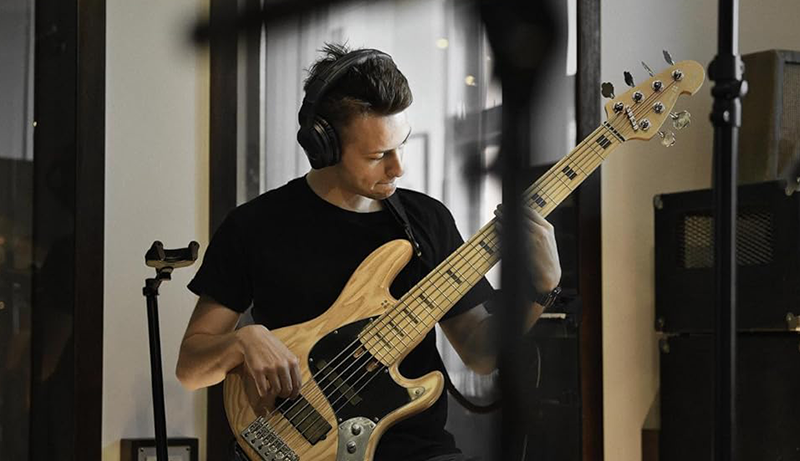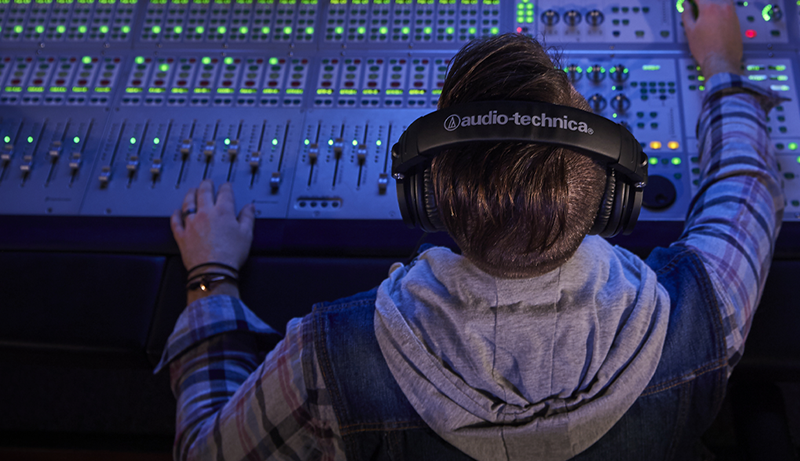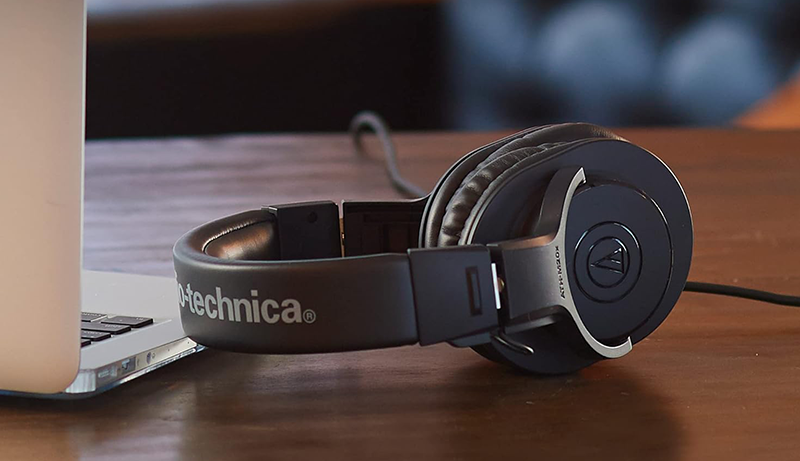Finding the right pair of headphones for practicing bass guitar isn’t always straightforward.
You need headphones that deliver a solid low-end response to capture the full depth of your bass tone, without losing the high-end clarity and soundstage necessary for clearly hearing backing tracks, click tracks, or other instruments.
After carefully reviewing a wide range of options, I’ve narrowed it down to five of the very best headphones for bass players. Whether you’re honing your skills at home or prepping for your next big performance, these picks are built to deliver reliable, high-quality sound.
1. Audio-Technica ATH-M50xBT2
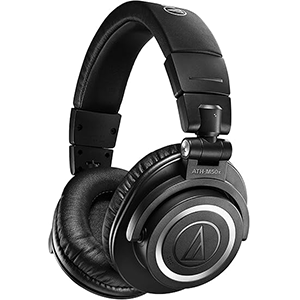
Musicians have traditionally avoided Bluetooth headphones due to latency issues that made them impractical for real-time practice. However, with Bluetooth 5.0 and Audio-Technica’s low-latency mode, the ATH-M50xBT2 changes that narrative, making wireless bass practice a reality.
These headphones also feature a detachable cable, so if you manage to drain the impressive 50-hour battery, you can instantly switch to wired mode and keep playing without interruption. Familiar to longtime Audio-Technica users, the fit and feel follow the brand’s proven design. The closed-back construction delivers a focused, intimate sound that emphasizes detail — perfect for identifying every nuance (and mistake) during practice.
While the closed design enhances clarity, it slightly limits soundstage depth. The non-breathable plastic earpads completely cover the ears, which can cause heat and discomfort during extended sessions. Still, they remain secure, even with movement — great for players who like to stand or groove while playing.
They also collapse for easy travel, making them a solid portable option. Despite minor comfort issues during long sessions, the ATH-M50xBT2 remains an excellent choice for bass players seeking clarity, versatility, and wireless convenience.
2. beyerdynamic DT 770 PRO
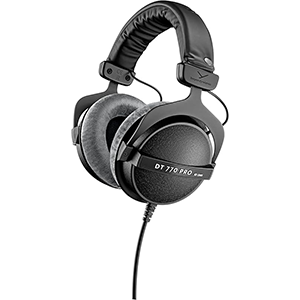
Unlike the widely used DT 990s, which are tailored for mixing and mastering, the more affordable Beyerdynamic DT 770s are ideal for general studio use, casual listening, and bass guitar practice.
One of the standout features of the DT 770s is their exceptional comfort. The soft, breathable earpads rest snugly over your ears, making long practice sessions easy without causing sweat or discomfort. Beyerdynamic clearly knows how to get the fit just right.
The closed-back design keeps your sound isolated and detailed, helping you focus on every nuance of your playing. The bass response is full and clear, easily handling deep, sub-heavy tones. I also appreciated the practical design — both the earpads and headband cover are replaceable, extending the headphones’ lifespan.
However, the cable is not detachable, which could be a drawback if it ever fails. While this issue has been addressed in the newer (and more expensive) DT 700 Pro X model, the standard 770s still offer tremendous value.
I recommend the 80-ohm version for most users, as the 250-ohm model may require a separate headphone amp. Overall, these are among the most comfortable and accurate headphones in their price range.
3. Sennheiser HD 280 Pro
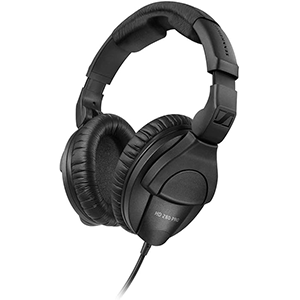
If you’re on a tight budget, the Sennheiser HD 280 Pro headphones are a solid choice for bass guitar practice. While they do make some compromises in build quality—the plastic construction feels a bit flimsy and they don’t always sit securely—they’re perfectly fine for stationary playing.
Sonically, they offer a well-balanced sound signature, with no part of the frequency range overpowering the rest. The bass is present, though slightly lacking in clarity. I found I had to adjust my tone to avoid muddiness in the low end. Still, for the price, the sound performance is respectable.
You won’t find many advanced features here, but they do come with a few practical perks: the earcups are replaceable, and the headphones fold down for easy portability. A coiled cable is also a nice inclusion at this price point.
However, comfort could be an issue during longer sessions. The non-breathable plastic earpads grip tightly, causing heat buildup and ear fatigue. Frequent breaks might be necessary, and you’ll want tissues nearby for the inevitable sweat.
Overall, the HD 280s offer great value for money, with dependable performance for practice and general use.
4. Sony MDR7506
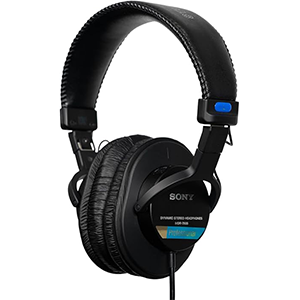
The Sony MDR-7506 headphones have long been a studio favorite, known for delivering clear, balanced audio at a very affordable price. Designed with simplicity in mind, they strip away unnecessary features to focus on providing reliable, professional-quality sound without inflating the cost.
That said, the build does reflect the budget-friendly approach. The headband adjustment feels a bit flimsy, and the earpads—made with a thin, plasticky material—tend to flake over time. Still, the larger pad shape helps distribute pressure more evenly, making them surprisingly comfortable for extended practice sessions.
In terms of sound, they offer a neutral, well-balanced profile that doesn’t fatigue the ears. While not exceptionally detailed, the clarity is more than sufficient for practice use. However, when pushing the bass too hard, the sound can become muddy—so keeping your tone a bit more mid-focused helps maintain clarity.
They also do a decent job of passive noise isolation, making them a solid option if you’re practicing in a noisy home environment. Overall, the MDR-7506 remains a dependable, no-frills choice for bassists who want solid performance without breaking the bank.
5. RODE NTH-100
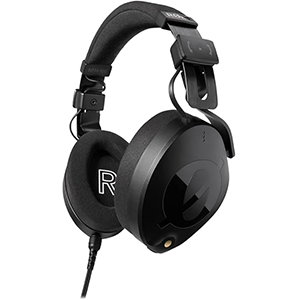
At first glance, the Rode NTH-100 Professional headphones seem like a perfect option for bass guitar practice—but there are a few important drawbacks to consider.
Starting with comfort and build, the NTH-100s shine. The memory foam earpads are soft, supportive, and stay comfortable even during extended sessions. Despite the mostly plastic design, the build feels sturdy and durable enough to survive the occasional drop. The oval-shaped earcups fully surround the ears, reducing pressure and enhancing comfort. Surprisingly, for a closed-back design, the soundstage is quite spacious.
Another highlight is the detachable cable, which adds convenience—especially in this price range. However, the downside is that Rode uses a proprietary locking mini-XLR cable. While it’s designed to prevent accidental disconnections, it also means you can’t easily replace it with standard alternatives, forcing you to rely on Rode for replacements.
The biggest drawback, though, is the audio clarity. While decent for basic use, the headphones lack the detail and separation needed for practicing with backing tracks or more complex arrangements, which may limit their appeal for serious practice.
Overall, the NTH-100s offer solid comfort and build but fall short in sonic precision.
Key Factors When Buying Headphones for Bass Guitar
Navigating headphone specifications can feel overwhelming if you’re not already fluent in the jargon. Here are the essentials to consider so you can choose a pair that truly suits your practice routine.
Open‑Back vs Semi‑Open vs Closed‑Back
Open‑back models have vented earcups that let air and sound escape. This reduces pressure on your ears, delivers a wider sense of space, and often sounds more natural. The trade‑off is near‑zero isolation: room noise leaks in, and your playing leaks out—fine for a quiet studio, less ideal for a busy home.
Closed‑back headphones seal the earcup, trapping the sound inside and blocking much of the outside world. You gain privacy and focus, but the soundstage can feel narrower. For solo bass practice—when you’d rather the household not hear every wrong note—closed‑back designs are often the best fit.
Semi‑open designs split the difference, offering a touch more openness without sacrificing too much isolation. They’re a practical compromise if you want better ambience yet still need to keep the volume contained.
Detachable Cables
Cables are the part most likely to fail. A detachable cord lets you swap in a new one in seconds, avoiding the chore (and cost) of soldering a replacement. If you prefer a non‑detachable design, be prepared for more involved repairs down the line.
Bluetooth & Latency
Wireless freedom is tempting—no more stepping on cords while you roam the room. Battery life on modern sets is usually ample, but latency is the real concern: too much delay makes playing in time impossible. Look for Bluetooth 5.0 or newer, and check whether the manufacturer offers a low‑latency or “gaming/musician” mode (Audio‑Technica, for instance, does).
Making the Right Choice
The low‑ to mid‑price market is fiercely competitive. Start by defining your must‑haves:
- Isolation level (open vs. closed)
- Cable options (detachable, Bluetooth, or both)
- Comfort for long sessions
Once you know what matters most—wireless freedom, replaceable parts, marathon comfort—it’s far easier to zero in on the perfect pair for your bass practice.

